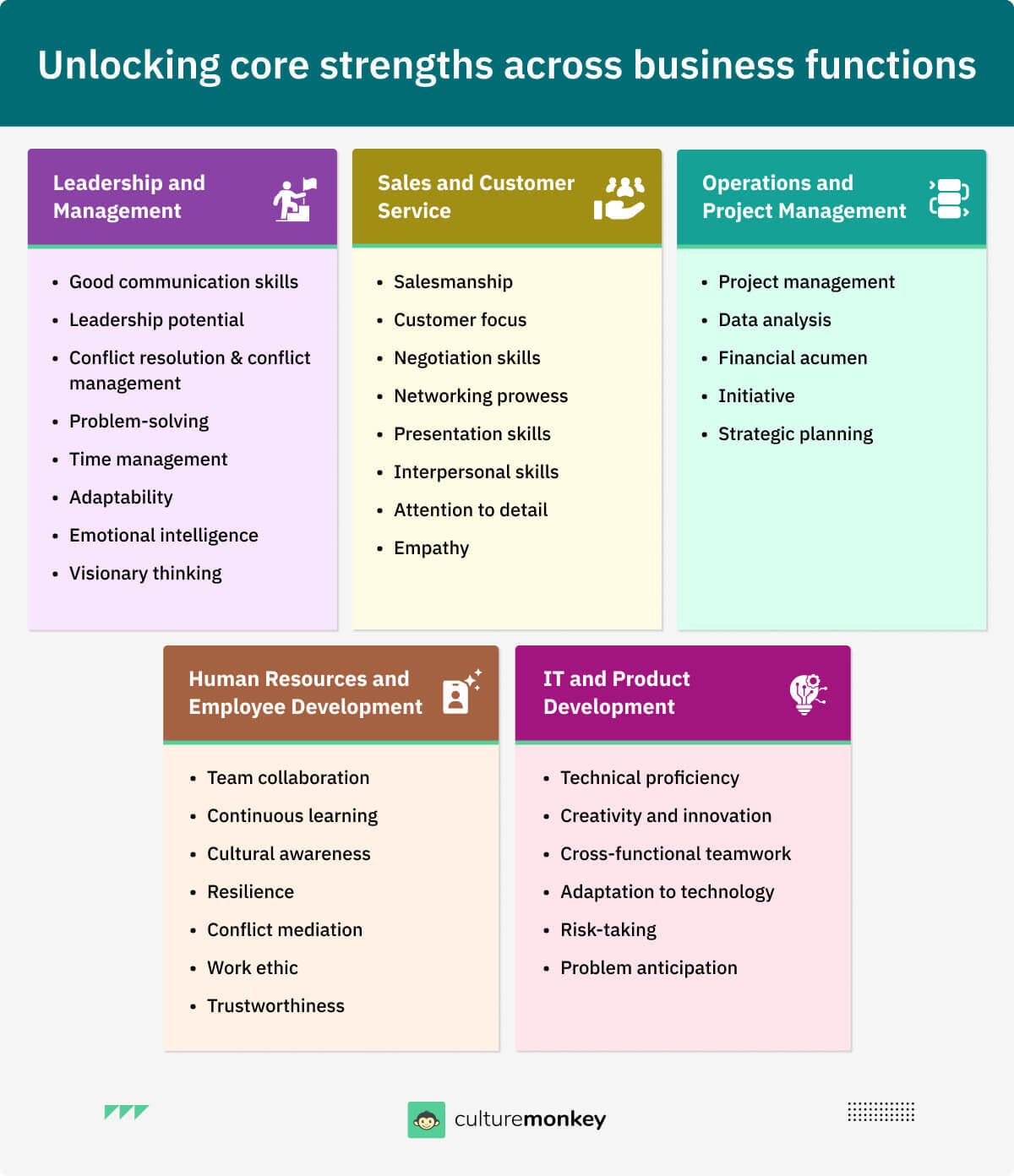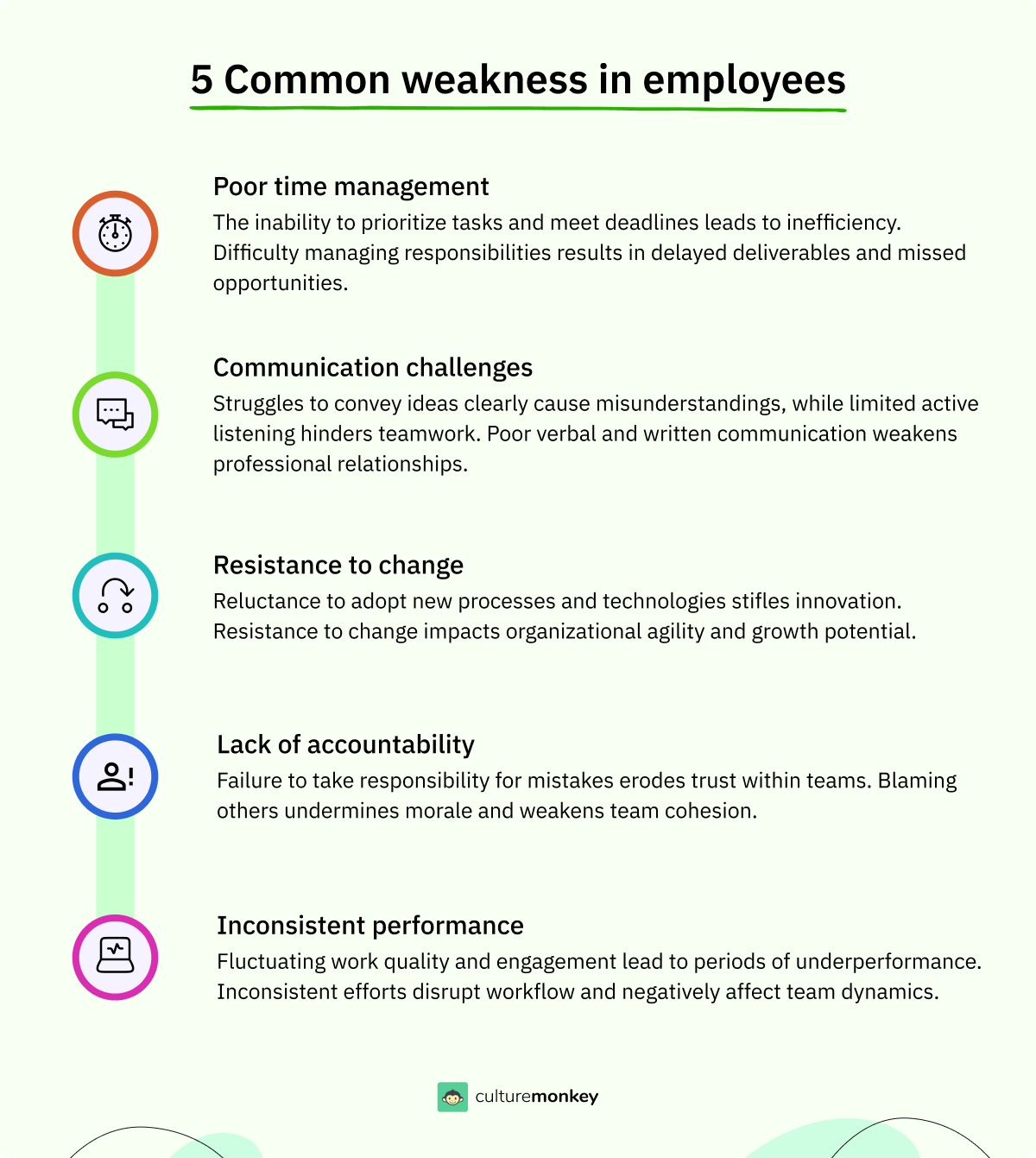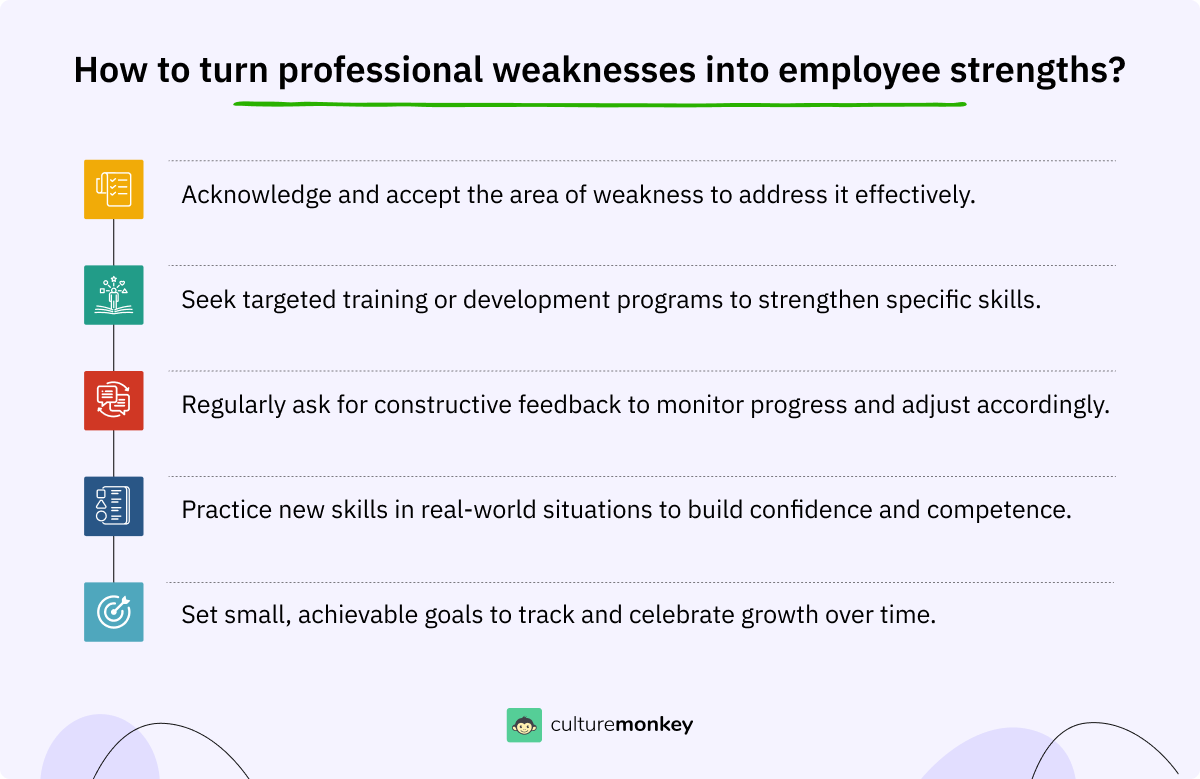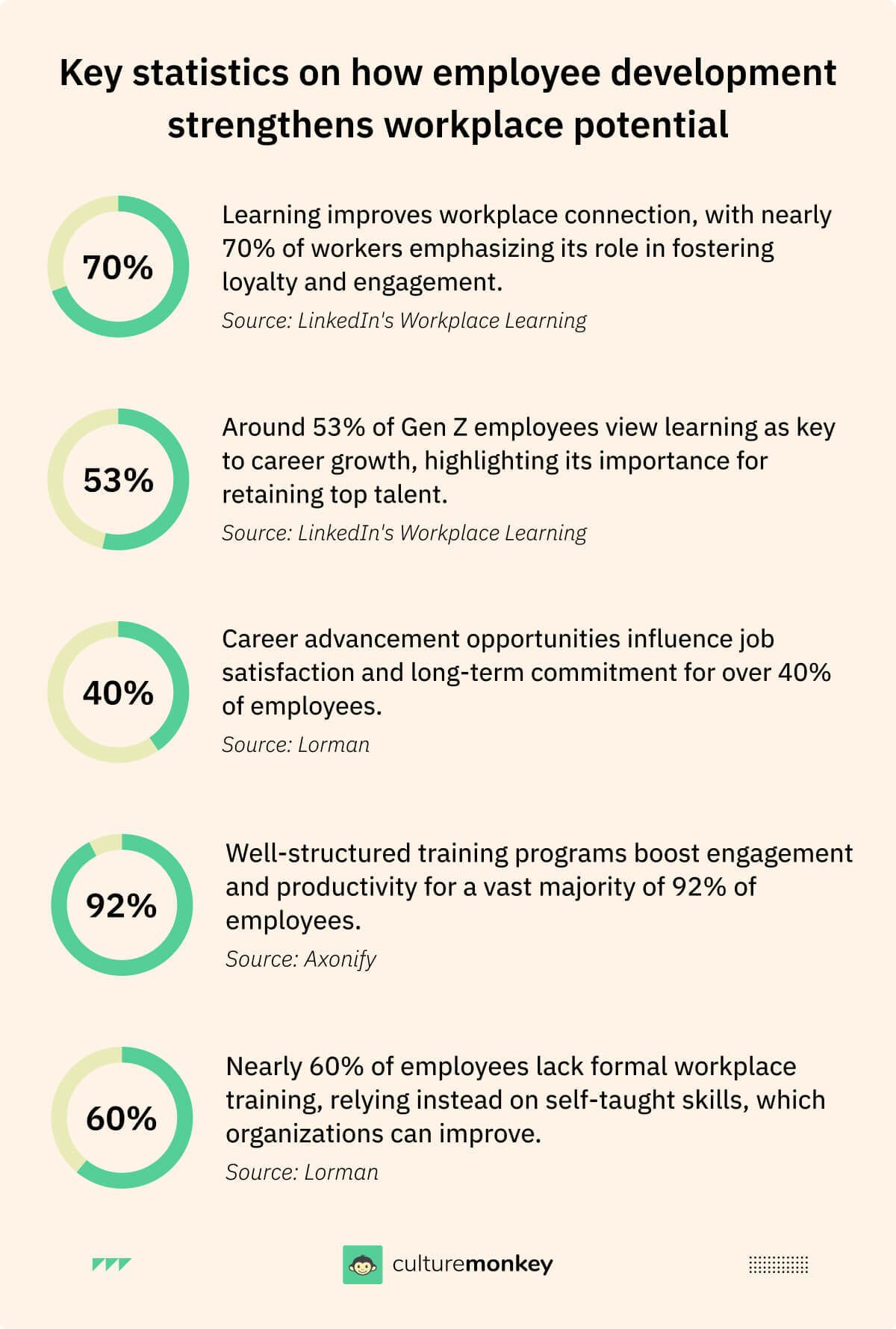Strengths in the workplace: Examples & tips to improve your people development plan

Imagine you're building a sports team. Would you assign your fastest player to be the goalie? Probably not. You'd place them where their speed gives you the most advantage—on the field, outrunning opponents.
The same logic applies to the workplace. When you align tasks with employees’ strengths, you not only boost productivity but also morale. Strengths aren’t just about skills, though. They include how people approach problems, interact with others, and handle pressure.
Many managers miss this, opting for the “one-size-fits-all” approach. But the real secret to a thriving, high-performing team lies in recognizing and leveraging each individual’s unique strengths.
Curious how this applies to your workplace? Let’s dive into why identifying and using strengths in the workplace is your game-changing strategy.
Blog Highlights


What are employee strengths?

Employee strengths are the foundation of organizational success, combining skills, talents, and inherent qualities each individual brings to the table. These strengths allow employees to excel in areas where they naturally thrive, delivering exceptional results.
Identifying these strengths is like discovering hidden gems—leaders can then create tailored development programs that align with employees' innate abilities, fostering growth and engagement.
By acknowledging strengths, leaders inspire confidence, purpose, and commitment, elevating both individual performance and overall team success. Recognizing employee strengths creates a ripple effect, leading to improved job satisfaction, higher engagement, and stronger team cohesion.
When leaders leverage these strengths strategically, they build a culture where individuals feel valued and empowered to contribute their best. Ultimately, this results in a more productive, innovative, and resilient organization that consistently moves toward success.
The importance of employee strengths in the workplace

Employee strengths are the hidden gems of a thriving workplace. They are not just individual attributes but powerful assets that can shape the culture and success of an organization.
Employee strengths drive productivity. When individuals work in roles that align with their strengths, they're more engaged, motivated, and efficient. Their tasks feel less like chores and more like opportunities for growth.
Strengths foster collaboration. In a diverse team, each member brings unique strengths to the table. When harnessed effectively, these strengths complement one another, leading to innovative problem-solving and creative solutions.
Strengths enhance job satisfaction. Employees who can apply their strengths at work experience a sense of fulfillment and achievement. This leads to higher job satisfaction and lower turnover rates.
They promote personal growth. Encouraging employees to develop and utilize their strengths not only benefits the organization but also the individuals themselves. It's a win-win scenario where professional growth aligns with company goals.
Lastly, strengths-based leadership can transform an organization. When leaders identify and leverage the strengths of their team members, it fosters a culture of appreciation and empowerment, ultimately driving business success.
3 Types of strengths employees bring to work
Every employee brings unique strengths that contribute to team success. Recognizing and using these strengths effectively boosts engagement and performance. Here are common strengths at work with examples of leveraging strengths in the workplace.
1. Hard skills (Technical strengths)
These include coding, data analysis, writing, legal expertise, and more—concrete abilities that are often learned through formal training or hands-on experience.
Work-related strengths are measurable, repeatable, and directly impact efficiency and accuracy. While they don’t always make someone a great collaborator or communicator, these skills are essential building blocks of high-performing teams—especially when paired with complementary soft strengths.
2. Soft skills (Interpersonal strengths)
Soft skills are all about how people relate, communicate, and work together. The strengths in the workplace include empathy, active listening, adaptability, and conflict resolution. While harder to quantify than technical skills, they are just as vital—if not more—in people-centric roles like HR, management, and customer service.
They foster trust, reduce friction, and elevate team performance. Without strong interpersonal strengths, even the most technically skilled team can struggle with collaboration, miscommunication, and low morale. These are the strengths that shape workplace culture from the inside out.
3. Creative strengths
Creative strengths show up as innovative thinking, storytelling, design, or problem-solving with flair. The strengths fuel campaigns, brainstorms, and product innovation. Whether it’s crafting brand messaging or finding fresh solutions to recurring problems, creative minds bring energy and originality to any team.
These strengths are especially valuable in marketing, product development, and design roles. Recognizing and nurturing this kind of talent ensures your organization remains fresh, future-focused, and ready to pivot. Creativity isn’t just artistry—it’s one of the most adaptive strengths in workplace success today.
What are 50+ good strengths your employees need in the workplace?

To lead is to guide, and to guide is to decipher the unique constellations of strengths that each employee brings to the celestial table. Let’s illuminate these 50+ cosmic strengths that, when harnessed, forge a constellation of unparalleled brilliance within your workforce.
Leadership and management
- Good communication skills: Effective communication is crucial for leaders to clearly convey ideas, motivate teams, and foster collaboration.
- Leadership potential: Leadership is about inspiring and guiding others to achieve collective goals, making this a key strength in management.
- Conflict resolution & conflict management: Leaders who can resolve conflicts constructively maintain harmony and ensure smooth team dynamics.
- Problem-solving: Managers who excel at identifying and resolving issues keep the organization moving forward efficiently.
- Time management: Proper time management helps leaders prioritize tasks and balance competing responsibilities effectively.
- Adaptability: Leaders who embrace change and guide teams through it create resilience and flexibility within the organization.
- Emotional intelligence: Understanding and managing emotions helps leaders build strong relationships and resolve conflicts smoothly.
- Visionary thinking: A crucial example of strengths in the workplace, effective leaders foresee trends and guide teams toward shared goals.
- Accountability: Owns responsibilities and results, good or bad. Builds a culture of reliability. Strengthens trust and ensures follow-through on commitments.
- Delegation: Knows what to do—and what to assign. Empowers others by sharing responsibility. Prevents bottlenecks and encourages employee growth.
Sales and customer service
- Salesmanship: Influencing and persuading others is crucial in sales roles, helping to pitch products or ideas persuasively.
- Customer focus: Prioritizing customer satisfaction is essential for building lasting relationships and ensuring repeat business.
- Negotiation skills: Successful negotiation leads to win-win deals that benefit both the customer and the company.
- Networking prowess: Building and maintaining a strong network can open doors to new clients and partnerships.
- Presentation skills: Clear and engaging presentations are key to closing sales and conveying value to clients.
- Interpersonal skills: Building strong connections with clients ensures better service, satisfaction, and loyalty.
- Attention to detail: Paying attention to client needs and preferences enhances the customer experience and drives repeat business.
- Empathy: Empathetic professionals deeply understand client needs, enabling them to easily build trust and long-term relationships.
- Relationship building: Strengthens bonds with clients and teams. Turns transactions into partnerships. Improves client lifetime value and employee connection.
- Active listening: Focuses on what’s said—and what’s not. Responds with relevance and care. Enables deeper understanding and tailored solutions.



The single biggest driver of business impact is the strength of an organization’s learning culture.
Founder and CEO
The Josh Bersin Company
Operations and project management
- Project management: Effective planning, coordination, and execution are critical to delivering projects on time and within budget. Using the right project management solution makes this process even more efficient.
- Attention to detail: Ensuring accuracy and quality is vital in operational processes to avoid errors and ensure smooth workflow.
- Adaptability: Flexibility is crucial in operations where unexpected changes often occur, and rapid adjustments are required.
- Data analysis: Analyzing data helps in making informed decisions, optimizing processes, and improving efficiency.
- Financial acumen: Understanding financial principles helps in managing budgets and making cost-effective decisions.
- Problem-solving: Analyzing and resolving operational challenges ensures smooth processes and continuous improvement.
- Initiative: Proactively seeking ways to improve efficiency and solve problems helps drive operational success.
- Strategic planning: Enables employees to prioritize goals and anticipate challenges for seamless project execution and operational success.
- Process improvement: Identifies inefficiencies and fixes them. Saves time, effort, and frustration. Boosts productivity and team morale with streamlined workflows.
- Goal orientation: Keeps a laser focus on outcomes. Motivates teams to deliver results. Aligns daily work with broader business impact.
Human resources and employee development
- Emotional intelligence: HR professionals must navigate interpersonal dynamics, resolve conflicts, and create positive environments.
- Team collaboration: Collaboration ensures effective hiring, onboarding, and team-building strategies, helping HR departments maintain a cohesive workforce.
- Continuous learning: HR leaders prioritize professional development opportunities that keep employees engaged and aligned with organizational goals.
- Cultural awareness: Ensuring inclusivity and respect for diversity is key to fostering a positive workplace culture.
- Resilience: HR professionals need resilience to manage conflicts and challenges, ensuring employee well-being and satisfaction.
- Conflict mediation: Skilled in preventing conflicts from escalating, HR professionals facilitate productive discussions to maintain harmony.
- Work ethic: A strong commitment to ethical practices ensures fairness and transparency in all employee interactions and decisions.
- Trustworthiness: HR professionals who are dependable, act with integrity build confidence among employees , creating a strong foundation of trust.
- Feedback delivery: Gives clear, helpful feedback with care. Helps others grow without discouragement. Improves performance and communication effectiveness.
- Inclusivity champion: Creates space for every voice to be heard. Actively builds belonging. Strengthens culture and attracts diverse talent.
IT and product development
- Technical proficiency: Mastery of tools and technologies is essential for product development, coding, and troubleshooting.
- Creativity and innovation: Original ideas drive the development of new products and solutions in tech roles.
- Cross-functional teamwork: Collaboration between tech teams and other departments ensures successful product launches and continuous improvement.
- Adaptation to technology: Staying current with evolving tech trends allows IT professionals to stay competitive and improve processes.
- Risk-taking: Calculated risk-taking is essential in tech roles for experimenting with innovative solutions and leading the way in technological advancement.
- Attention to detail: Ensuring technical accuracy minimizes bugs and errors in product development, enhancing quality and reliability.
- Initiative: IT professionals who take the lead in identifying and resolving potential issues ensure the smooth functioning of technological processes.
- Problem anticipation: this strength ensures reliable systems, efficient processes, and fosters innovation in tech-driven environments.
- Systems thinking: Understands how parts connect in a larger system. Considers the downstream impact of technical choices. Optimizes scalability, integration, and long-term reliability.
- Testing and QA mindset: Thinks critically about what could break. Writes, runs, and respects test coverage. Reduces regressions and improves end-user trust.

Aligning strengths with roles for maximum impact
When employees are placed in positions that match their natural abilities, both individual performance and overall business outcomes improve.
- Tailored role design: Customizing job roles to match employees' strengths ensures they are working in areas where they naturally excel. This leads to higher engagement and more consistent, high-quality performance.
- Improved efficiency: When employees utilize their strengths, tasks are completed more efficiently. This alignment reduces the learning curve for new responsibilities and streamlines workflows, boosting productivity across teams.
- Enhanced employee confidence: Assigning roles that leverage strengths fosters a sense of confidence among employees. They feel more capable and valued, which enhances motivation and drives higher performance.
- Greater role satisfaction: Employees who perform tasks aligned with their strengths are more likely to feel fulfilled in their roles. This alignment leads to greater job satisfaction and a more positive workplace environment.
- Stronger team synergy: When team members work in roles that match their strengths, collaboration becomes more effective. Complementary strengths across teams lead to better problem-solving and more innovative outcomes.
- Accelerated skill development: Focusing on strengths in specific roles also provides employees with opportunities to further develop these areas. This ongoing development leads to personal growth and enhanced performance over time.
Why interviewers ask about strengths and weaknesses
Interview questions about strengths at work and weaknesses aren't trick questions—they reveal self-awareness. Recruiters look for signs of growth, adaptability, and team alignment. Knowing your strengths shows how you'll contribute meaningfully from day one.
- To assess self-awareness: Interviewers want to know if you recognize your key strengths at work and your gaps. It’s a sign that you’re thoughtful, grounded, and growth-minded.
- To evaluate cultural and role fit: Certain work strengths align better with specific roles or work environments. Employers are checking how your working strengths fit into their team dynamic and mission.
- To understand learning agility: By hearing how you talk about weaknesses, they assess your ability to improve. Great candidates balance strengths and areas of development examples with humility and strategy.
- To validate resume claims: Interviewers use your answers to match stated experience with real-world behavior. Discussing the strength of an individual at work adds credibility to your profile.
- To plan future development: Your employee strengths today could become leadership assets tomorrow. Interviewers want to know how your areas of strength at work might grow within the company.
- To test communication under pressure: Explaining your strengths at work clearly under pressure shows how you handle tough conversations—a valuable skill in any high-functioning team.
Strengths vs. weaknesses: Why both matter in 2025
Embracing both strengths and weaknesses helps us grow, collaborate better, and lead more authentically. As we move into measuring workplace strengths in 2025, a well-rounded approach is key to building a resilient, high-performing workforce.
| Strengths | Weaknesses |
|---|---|
| Natural talents or professional strengths like empathy, creativity, or problem-solving | Areas that need development: time management, delegation, or communication gaps |
| Boost engagement and confidence when applied to the right roles | Reveal growth potential and opportunities for coaching or support |
| Help shape a strengths-based culture rooted in authenticity and contribution | Encourage humility, openness, and a learning mindset |
| Identified through strengths assessment tools or real-time feedback | Often discovered through feedback loops, reflection, or performance reviews |
| Align well with roles that require specific work-related strengths | When acknowledged, they prevent overconfidence and poor team dynamics |
| Key contributors to performance and workplace success traits | Balancing weaknesses ensures long-term adaptability and growth |
Which employee strengths should be looked at in job interviews?
Identifying strengths in the workplace during job interviews ensures you select candidates who align with your company’s needs and culture. Here are five key steps to evaluate the areas of strength at work that matter most:
- Assess problem-solving abilities: Problem-solving is a critical work-related strength across industries. Ask candidates to describe specific challenges they have faced and how they approached resolving them. Their responses reveal creativity, resilience, and logical thinking—key strengths to build on at work.
- Evaluate communication skills: Effective communication is one of the key strengths in the workplace. Pay attention to how candidates articulate their thoughts during the interview. Ask situational questions to assess their listening, verbal, and written communication abilities, showcasing demonstrated strengths at work.
- Look for adaptability: In today’s fast-paced environments, flexibility is crucial. Ask about situations where they had to adapt to new tools or team dynamics. Adaptability is among the top 3 work-related strengths for navigating change effectively.
- Examine teamwork and collaboration: Collaboration reveals the strengths of an individual at work and their ability to complement team dynamics. Ask candidates to share examples of successful projects, showcasing what are your peers’ strengths and how they synergized effectively.
- Gauge their initiative and self-motivation: Candidates who demonstrate a proactive attitude possess one of the examples of strengths in the workplace that drive growth. Ask how they have leveraged personal strengths like initiative to improve processes or solve problems
Mistakes to avoid in a strengths-based approach
Implementing a strengths-first approach takes more than identifying what people are good at. Real transformation requires clarity, balance, and intentional strategy. Here are some common mistakes to watch out for when applying a strengths-based approach in the workplace:
- Focusing only on obvious strengths: Some talents are loud and visible, but others—like quiet leadership or deep listening—are subtle. If you only reward extroverted traits, you risk overlooking key work related strengths that drive performance behind the scenes.
- Ignoring context and role fit: Just because someone excels at something doesn’t mean it belongs in every scenario. Misapplying strengths can lead to burnout and confusion, undermining both organizational strengths and employee potential.
- Confusing strengths with job titles: Don’t assume a role defines someone’s value. A marketer may have strong coaching instincts. Discovering true strengths in workplace settings requires asking, what are areas of strength at work that go beyond their job description.
- Neglecting development areas: While strengths matter, ignoring weaknesses completely isn’t smart. The goal is balance: emphasize strengths and opportunities for growth, not perfection.
- Lacking a feedback loop: Without feedback and reflection, you won’t know if your strengths-based system is working. Regular check-ins help uncover hidden strengths to have in the workplace and fine-tune approaches.
- Applying a one-size-fits-all model: Everyone brings a different mix of organizational strengths. Cookie-cutter development plans waste potential; customization is where a strengths-based strategy truly shines.
14 Key strengths at work and in personal life

Here are 14 key strengths in the workplace and in personal life that can truly make a difference:
Strengths at work
- Adaptability and resilience: In today's fast-paced world, adaptability is a prized strength. Employees who can quickly adjust to new situations and bounce back from setbacks demonstrate remarkable resilience. They bring a sense of stability to the workplace, even when faced with unexpected challenges.
- Digital fluency: As technology continues to shape the business landscape, employees with digital fluency are invaluable. They not only keep up with the latest tech trends but also understand how to leverage digital tools to enhance productivity and communication.
- Inclusivity champion: A diverse and inclusive workplace is essential for innovation and growth. Employees who actively promote inclusivity, respect different perspectives, and champion diversity contribute to a more welcoming and collaborative atmosphere.
- Strategic thinker: While problem-solving is crucial, having employees who can think strategically is a game-changer. They see the bigger picture, set long-term goals, and develop plans to achieve them. Strategic thinkers help steer the organization toward success.
- Adaptive leadership: Leadership isn't just about titles; it's about inspiring others. Employees who exhibit adaptive leadership traits empower their colleagues, offer guidance when needed, and promote a culture of continuous improvement.
- Remote work proficiency: In the age of remote and hybrid work, employees who excel in virtual collaboration are indispensable. They know how to navigate digital platforms, maintain productivity from afar, and keep remote teams connected.
- Emotional resonance: Understanding and managing emotions is crucial for effective teamwork and leadership. Employees with high emotional intelligence can navigate interpersonal dynamics, resolve conflicts, and create a positive work environment.
Personal strengths
- Integrity: Upholding strong moral and ethical principles is a valuable strength. Employees with integrity are trustworthy and demonstrate honesty and transparency in their work, which fosters a culture of trust within the organization.
- Empathy: Empathetic individuals excel in understanding and connecting with the emotions and needs of their colleagues and clients. This strength is especially valuable in roles that require strong interpersonal relationships, such as customer service and leadership.
- Initiative: Taking the initiative to identify opportunities for improvement and proactively addressing challenges is a strength that can drive innovation and growth within a company. Employees who exhibit this trait are often seen as go-getters.
- Patience: Patience is a virtue, especially in roles where patience is essential for problem-solving or when working with clients who may have complex needs. Patient individuals can maintain composure in high-stress situations.
- Attention to detail: While mentioned briefly in previous job duties, it's worth emphasizing that a keen eye for detail is a crucial strength in roles that require precision, quality control, or data analysis. It ensures accuracy and minimizes errors.
- Networking: Building and maintaining professional relationships both within and outside the organization is a valuable strength. Employees with strong networking skills can open doors to collaborations, partnerships, and opportunities.
- Adaptive thinking: In rapidly changing industries, being able to adapt your thinking and strategies to new circumstances is a significant strength. It allows you to stay focused, relevant and make well-informed decisions even in unpredictable situations.
How to assess employee strengths

Understanding employee strengths is essential for aligning talent with the right roles and fostering long-term growth. Here are key strategies for effectively assessing employee strengths:
- Observation of daily work habits: Leaders can gain valuable insights by observing employees’ daily performance. Tasks that employees handle with ease and enthusiasm often reveal their core strengths. Consistent excellence in specific areas can point to natural abilities.
- Task-based projects: Assigning employees to varied, task-based projects helps identify which roles or responsibilities they perform exceptionally well. This can highlight strengths in areas such as project management, teamwork, or creativity.
- Leadership development programs: Offer leadership or professional development programs and observe how employees engage. Those who thrive in these settings often demonstrate key strengths like initiative, decision-making, or mentorship abilities.
- Cross-functional collaboration: Encouraging employees to work with other teams reveals how well they communicate and adapt to different environments. Cross-functional projects often show strengths in teamwork, problem-solving, and collaboration.
- Use of simulations and real-life scenarios: Incorporate simulations or role-play exercises that mimic real-life challenges. These scenarios can showcase how employees apply their strengths in high-pressure situations or in problem-solving tasks.
- Feedback from external clients: Feedback from clients or external stakeholders can provide a different perspective on employee strengths. Positive interactions with clients often highlight strengths in communication, customer service, and relationship-building.
- Employee surveys: Conduct regular employee surveys to gather insights on how employees perceive their own strengths and where they feel most confident. Surveys can help identify areas where employees feel most engaged and where their strengths are best utilized, providing valuable data for aligning roles and growth opportunities.

Turn employee potential into workplace excellence
Discover 10 activities to identify and strengthen skills, boosting growth, productivity, and engagement.
What are employee weaknesses?
Employee weaknesses refer to areas where individuals may lack the skills, confidence, or habits required to perform at their best. Common weaknesses such as poor time management, ineffective communication, or resistance to change can hinder employees’ ability to meet deadlines, collaborate effectively, or adapt to evolving workplace demands.
These weaknesses not only impact individual performance but can also affect team dynamics, creating friction, delays, or missed opportunities for innovation. Identifying these areas of improvement is the first step in transforming them into strengths through targeted support and development.
When employee weaknesses go unaddressed, they can lead to broader organizational challenges. For instance, procrastination or lack of accountability can delay projects, lowering overall productivity. Poor communication can result in misunderstandings, disrupting workflows and client relationships.
Additionally, weaknesses like low confidence or resistance to change can stifle creativity and limit employee engagement. Businesses that fail to recognize and address these issues risk higher turnover, reduced morale, and missed opportunities for growth.
By proactively identifying and addressing weaknesses, organizations can support employees in overcoming these challenges and foster a culture of continuous improvement that benefits everyone.



If learners think it looks bad, you may have lost a good percentage of the battle in getting them to pay attention.
President
Learning Peaks, LLC
15 Common weakness in employees

Identifying common weaknesses in employees is essential for fostering professional development and enhancing organizational effectiveness. While every individual brings unique strengths to the table, recognizing and addressing prevalent weaknesses can lead to targeted improvement strategies and overall growth. Here are 15 common weaknesses often observed in employees:
- Poor time management: Inability to prioritize tasks effectively and meet deadlines. Lack of organization leads to inefficiency and decreased productivity. Difficulty in managing multiple responsibilities simultaneously, resulting in missed opportunities and delayed deliverables.
- Communication challenges: Struggles to convey ideas clearly and concisely, leading to misunderstandings. Limited active listening skills hinder effective collaboration and teamwork. Inadequate verbal and written communication skills impair professional relationships and hinder progress on projects.
- Resistance to change: Reluctance to adapt to new technologies, processes, or procedures. Fear of stepping out of comfort zones and embracing innovation. Resistance to change impedes organizational agility and inhibits growth opportunities.
- Lack of accountability: Failure to take ownership of mistakes or shortcomings. Blaming others instead of accepting responsibility for actions. Absence of accountability erodes trust within teams and undermines morale.
- Inconsistent performance: Fluctuating work quality and productivity levels. Lack of motivation or engagement leads to periods of underperformance. Inconsistent performance disrupts workflow continuity and impacts overall team dynamics.
- Resistance to change: Hesitation to adopt new processes limits the use of key strengths at work. Resistance slows innovation and disrupts workflows. Training and open communication encourage adaptability.
- Procrastination: Delays in tasks reduce productivity and team efficiency. Prevents employees from utilizing areas of strength at work effectively. Coaching improves time management and focus.
- Lack of confidence: Self-doubt hinders personal strengths like leadership or creativity. Limits initiative and idea contribution. Mentorship builds confidence and unlocks potential.
- Overcommitment syndrome: Some employees have difficulty saying no, leading to taking on more tasks than they can handle. While their enthusiasm is commendable, overcommitment may lead to burnout and compromised quality of work.
- Perfectionism paralysis: While attention to detail is vital, excessive perfectionism can lead to prolonged project timelines and missed opportunities. Employees should strike a balance between striving for excellence and knowing when a task is satisfactorily complete.
- Difficulty with delegation: Some individuals find it challenging to delegate tasks, fearing that others won't meet their standards. This hampers their own efficiency and the growth of their team. Learning to delegate effectively and trust others' capabilities is essential.
- Resistance to change: Averse to change, certain employees may cling to familiar methods, hindering adaptation to new technologies or processes. Embracing change with an open mindset ensures continued growth and innovation.
- Lack of assertiveness: Employees who struggle with assertiveness may find it challenging to voice opinions or advocate for themselves. Developing assertiveness skills empowers them to communicate effectively, contribute ideas, and address concerns.
- Impatience with routine: Routine tasks can bore some employees, impacting their engagement and efficiency. Recognizing the importance of routine and finding ways to infuse variety or challenge can help alleviate this weakness.
- Difficulty with receiving feedback: Those who struggle to accept constructive criticism may hinder their personal and professional growth. Acknowledging that feedback is an avenue for improvement, not criticism, fosters continuous development.

How to turn professional weaknesses into employee strengths?

Transforming professional weaknesses into employee strengths is not only possible but can be a powerful journey of personal and career development. Here are five steps to help you turn your weaknesses into strengths:
- Self-awareness: The first step is acknowledging your weaknesses honestly. This requires self-awareness and humility. Identify specific areas where you struggle or have received constructive criticism. It could be time management, public speaking, or a lack of technical skills.
- Set clear goals: Once you've identified your weaknesses, set clear and achievable goals for improvement. Define what "strength" looks like in that area. For instance, if you struggle with public speaking, your goal might be to confidently deliver a presentation to a large audience.

- Seek training and resources: Take proactive steps to address your weaknesses. Enroll in workshops, courses, or training programs that target your specific area of improvement. Utilize online resources, books, or mentorship to gain knowledge and skills.
- Practice and feedback: Improvement often comes through consistent practice. Apply what you've learned in real-world situations. If it's a communication weakness, practice speaking in front of smaller groups first. Seek feedback from peers, mentors, or supervisors to refine your skills.
- Perseverance: Transforming weaknesses into strengths is a journey that requires time and patience. Don't get discouraged by setbacks or slow progress. Stay committed to your goals and continue to learn and grow.
How to identify your workplace strengths?

Ever feel completely in your element during certain tasks? That’s not a coincidence—it’s a sign you’re working in alignment with your core strengths. Discovering what energizes you at work helps you lead with confidence and make meaningful contributions where you perform best.
- Self-assessment tools: Utilize assessment tools to gain insights into your natural abilities. These tools help highlight your key strengths and how they can be applied in the workplace.
- Analyze past successes: Reflect on projects or tasks where you’ve excelled. Consider the specific skills and qualities that contributed to your success—these are likely areas of strength.
- Ask for feedback: Seek feedback from colleagues, managers, or mentors who have observed your performance. They can provide an external perspective on the areas where you naturally shine.
- Evaluate your energy levels: Notice which tasks energize you versus those that drain you. Tasks that leave you feeling motivated and engaged are often aligned with your strengths.
- Performance reviews: Regular performance evaluations offer valuable insights into areas where employees excel. By focusing on both quantitative and qualitative feedback, leaders can identify key strengths demonstrated through specific tasks and accomplishments.
- Behavioral interviews: Behavioral interviews involve asking employees to describe how they handled past challenges. Their responses can reveal key strengths such as leadership, adaptability, and conflict resolution.
- Pay attention to compliments: Take note of compliments you receive about your work. Colleagues often recognize strengths in you that you might overlook.
How to help employees develop their strengths?

Helping employees develop areas of strength in the workplace requires a supportive strategy. Begin by identifying work-related strengths through assessments, feedback, and observation. Align these key strengths in the workplace with roles where employees can excel. Tailored opportunities like workshops or projects help employees build on what are my strengths at work.
Celebrate progress and encourage a culture of learning to reinforce strengths to build on at work. Mentorship programs can guide employees in developing their demonstrated strengths at work further. Tools like CultureMonkey enable tracking examples of leveraging strengths in the workplace, empowering leaders to align roles with what personal strengths help you do your job effectively.
Providing employees with constructive feedback is another essential step in fostering their growth. Feedback sessions should highlight their areas of strength in work, offering specific examples of how these strengths have positively impacted their performance and the team. Constructive feedback should also guide employees on how to refine their work-related strengths of an individual and address areas that need improvement.
Encouraging employees to set personal development goals and providing the resources to achieve them reinforces their commitment to growth. By creating an environment where feedback is seen as an opportunity rather than a critique, organizations can nurture a culture of continuous improvement and engagement.
How amplifying employee strengths can make your organization stronger?

Every team member brings unique strengths to the table—and when those strengths are recognized and amplified, overall performance improves. When organizations invest in nurturing both individual and team capabilities, they create a stronger, more resilient culture that performs better and feels more engaged, every single day.
- Enhanced productivity: When employees work in roles that align with their strengths, they become more engaged and motivated. They perform tasks with greater efficiency and enthusiasm, ultimately to boost employee morale and productivity across the board.
- Innovation and problem-solving: Each employee possesses a unique set of leadership skills and perspectives. By encouraging them to leverage their strengths, you create a diverse team that excels at innovation and creative problem-solving. Different strengths lead to fresh ideas and approaches.
- Higher job satisfaction: When employees feel that their strengths are recognized and valued, they experience higher levels of satisfaction accordingly to their job description. This, in turn, leads to reduced turnover rates and a more stable workforce.
- Improved employee engagement: Focusing on strengths promotes a company culture of empowerment and recognition. Employees feel a sense of ownership over their work, leading to higher levels of engagement and commitment to the organization's goals.
- Better team dynamics: Teams composed of individuals who understand and appreciate each other's strengths collaborate more effectively. They can delegate tasks based on each team member's strengths, leading to smoother workflows and better outcomes.
- Leadership development: Identifying and nurturing strengths among potential leaders can lead to a strong leadership pipeline within your organization. Future leaders who understand their strengths can lead with authenticity and effectiveness.
- Competitive advantage: A workforce that leverages its strengths is more adaptable and resilient in the face of challenges. This adaptability can be a significant competitive advantage in today's rapidly changing business environment.
- Customer satisfaction: When employees are encouraged to use their strengths to meet customer needs, it often results in better customer experiences. Employees who excel in areas like communication or problem-solving can directly impact customer satisfaction.
- Organizational growth: Strength-based development isn't just about individual growth; it contributes to the overall growth and success of the organization. By maximizing the potential of your workforce, you position your company for long-term success.
Tools and assessments to measure workplace strengths
You can’t amplify what you don’t understand. The right tools help uncover the hidden talents on your team and make strengths-based leadership more than just a buzzword. Here are six trusted tools and methods to help you build a more aware, empowered workforce:
- CultureMonkey: These pulse surveys and feedback tools uncover work-related strengths and engagement patterns across departments, supporting real-time strategy for a strengths-based culture.
- CliftonStrengths (formerly StrengthsFinder): One of the most widely used tools for identifying 34 distinct professional strengths, this assessment helps individuals and teams understand how they naturally think, feel, and perform.
- DISC Personality Assessment: While not solely focused on strengths, DISC offers insight into behavioral styles that impact collaboration, communication, and key workplace success traits—making it a practical tool for team alignment.
- VIA Character Strengths Survey: Grounded in positive psychology, this tool reveals personal values and professional strengths—ideal for developing emotional intelligence and purpose-driven performance.
- 360-Degree Feedback Tools: By gathering insights from peers, managers, and reports, this approach creates a well-rounded strengths assessment while also flagging blind spots and growth areas.
- Custom Role-Based Assessments: Some organizations build internal tools to measure skills tied directly to role-specific work-related strengths, ensuring every employee’s potential is matched to business needs.
Conclusion
Recognizing and nurturing employee strengths is the foundation of organizational success. When businesses focus on identifying and leveraging these strengths, they unlock higher productivity, improved morale, and stronger team collaboration.
Employees who can thrive in roles that align with their strengths feel more valued and engaged, driving individual and collective performance to new heights.
CultureMonkey empowers organizations to build on these strengths through its people science backed platform. By offering customizable survey templates, real-time analytics, and actionable insights, CultureMonkey enables leaders to identify key strengths and areas for growth within their teams.
Its intuitive tools help foster a culture of continuous improvement by aligning employee capabilities with organizational goals. With CultureMonkey, businesses can proactively nurture talent, reduce disengagement, and create a resilient, high-performing workforce.
Ready to unlock the full potential of your team? Schedule a demo with CultureMonkey today!
Summary
Strengths in the workplace are crucial for boosting employee engagement and productivity. Identifying and leveraging strengths helps employees excel in their roles and contributes to organizational success. Recognizing strengths leads to higher job satisfaction, better team dynamics, and improved performance. Managers can foster a strengths-based culture by using tools like surveys, offering feedback, and tailoring development opportunities to individual talents.
FAQs
1. How can managers leverage employee strengths to enhance performance?
Managers can enhance performance by identifying and assigning tasks that align with employees' strengths. Placing individuals in roles that match their natural abilities boosts productivity, efficiency, and engagement. Providing regular feedback, development opportunities, and encouragement allows employees to refine their strengths, further enhancing performance, team success, and long-term growth within the organization. This approach fosters motivation and innovation.
2. What are character strengths in the workplace?
Character strengths in the workplace refer to inherent qualities such as resilience, integrity, empathy, and perseverance. These traits contribute to how employees handle challenges, interact with others, and make decisions effectively. Leveraging character strengths helps create a positive work environment, drives collaboration, enhances employee relationships, boosts team morale, and supports personal and professional growth across the organization.
3. How can employees communicate their strengths effectively during performance reviews?
Employees can effectively communicate their strengths during regular performance reviews, by providing specific examples of tasks or projects where their strengths contributed to success. Highlighting measurable outcomes, such as increased productivity, improved team collaboration, or enhanced problem-solving, reinforces how their strengths align with the organization’s goals, demonstrates their value, and showcases their potential for future growth and responsibilities.
4. How can recognizing team members' strengths improve teamwork and collaboration?
Recognizing team members' strengths fosters an environment where individuals are encouraged to contribute their best. It allows team members to complement each other's abilities, improving communication, collaboration, and problem-solving. This recognition also builds trust, mutual respect, and a sense of belonging within the team, leading to higher morale, more successful outcomes, and a stronger, more cohesive team dynamic.
5. How can focusing on strengths improve employee satisfaction and retention?
Focusing on strengths allows employees to work in roles where they feel confident and engaged. This alignment leads to higher job satisfaction, a greater sense of achievement, and a feeling of being valued. Employees are more likely to remain loyal to organizations that recognize and nurture their strengths, improving retention and fostering long-term commitment and overall organizational success.
6. Can workplace strengths be developed over time?
Yes, many workplace strengths evolve with experience, feedback, and intentional practice. A strength of an individual at work can emerge through real-world challenges, mentorship, or training. Over time, employees may build new key strengths at work, transforming areas of strength at work into standout capabilities. Growth-focused cultures support both employee strengths and development.
7. How should managers leverage team members' strengths?
Managers should assign tasks aligned with work related strengths to boost engagement and performance. For example, pairing creative thinkers with brainstorming sessions is a classic example of leveraging strengths in the workplace. Understanding what strengths this individual demonstrates allows leaders to balance teams, improve morale, and maximize impact across various working strengths.
8. How do strengths differ from skills or talents at work?
Strengths at work are traits you consistently perform well and enjoy using, like empathy or adaptability. In contrast, skills are learned, and talents are natural aptitudes. While skills and talents support you, employee strengths sustain you. Clear examples of strengths in the workplace show that it’s not just what you do, but how effortlessly and meaningfully you do it.
9. What’s the difference between strengths and skills?
Strengths reflect natural talents or traits—like creativity or empathy—while skills are learned through training or experience. Think of hard and soft skills at work as tools, and strengths as how intuitively you use them. Identifying the top strengths employers look for helps teams align roles better through employee strengths assessment tools and smarter hiring.
10. Why are strengths important in employee performance?
Focusing on strengths increases motivation, engagement, and output. By leveraging strengths at work, companies boost productivity while reducing burnout. Strengths-based leadership fosters self-awareness, balances strengths and weaknesses in the workplace, and supports talent development. When you build around common workplace strengths, you create teams that thrive—not just survive—guided by real, measurable insight.
11. How do organizations assess strengths in the workplace?
Organizations assess strengths in the workplace by using tools like strengths assessments, 360-degree feedback, and performance data. Combining self-evaluations with peer and manager insights gives a full picture. Continuous feedback helps track evolving strengths, allowing better role alignment and focused development, which enhances team dynamics and drives stronger business results.
12. How do cultural differences impact strengths in the workplace?
Cultural differences influence workplace strengths by shaping communication, problem-solving, and work preferences. Recognizing these differences promotes an inclusive environment where diverse strengths are valued. Embracing cultural diversity leads to improved collaboration and innovation, as teams leverage unique perspectives and approaches, making them more adaptable and effective in achieving organizational goals.




